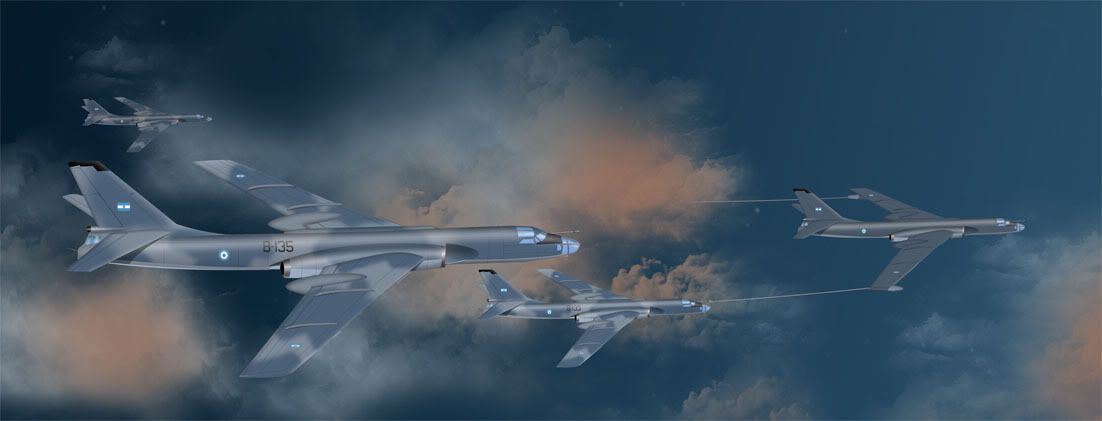The raid on Ascension Island
2nd-3rd April 1982In the late 1970ís the Argentinian armed forces went through a modernization and expansion program.
Most of the new hardware bought was from Soviet origin.
Among the equipment for the Air Force, none was more controversial that the Tupolev Tu-16.
The Soviet Union delivered a total of 5 standard tu-16s, alongside 3 tanker versions.
Ostensible, the regular Tu-16s were bought not as bombers but as long-range patrol and reconnaissance aircraft.
Either these aircraft were standard bomber or where modified to that standard latter, the fact was that by the early 1980ís they were used in exercises in the bomber role.
One of the main aspects of the Argentinian plan to invade the Falklands/Malvinas Islands was to delay the response of the UK armed forces for as long as possible.
In that sense, disabling the UK bases on Ascension Island was deemed as crucial.
The Island was host to forces of the RAF (Patrol aircraft) and RN.
In the Argentinian arsenal, only the Tu-16 force could do that mission with any chance of success.
For that mission, 3 bomber versions supported by 2 tankers were designated; the bomber aircraft were stripped of almost all non-essential equipment and left with a reduced bomb load; the tanker version
The mission package had also the assistance of one Boeing 707 that acted as command and control aircraft, not only detecting enemy activity but also guiding the bombers to their targets.
The aircraft took off from BAM Palomar, near Buenos Aires, at the night of 2nd of April expecting to arrive at the target around dawn of the 3rd.
The in leg of the mission was uneventful, with the aircraft refueling (both the Tu-16 bombers and the Boeing 707), the last one just around the early hours of the day; after that, the tankers turned around and the other aircraft headed to their destination.
One of the Tu-16 attack first with cruise missiles and was followed by the other two that launched free fall bombs.
The damage inflicted was more noticeable on the naval facilities; the Air Base was not put out of action and only one aircraft parked was destroyed; the runaway was hit by some bombs but the damage was small.
Some communications and radar facilities were destroyed as were some fuel reservoirs.
As stated, the naval facilities took the heavier toll and needed extensive repairing.
Having completed their mission both the Tu-16 and the Boeing 707 turned around and headed to a pre-arrangement point to perform a new air-to-air refueling.
What followed next what was certainly one of the most bizarre episodes of this conflict and even perhaps of the entire history of air warfare.
As the airplanes were moving away, the Boeing crew alerted the other planes, that an aircraft had managed to take off from Ascension and was heading in their direction.
As no reports were known of fighter planes stationed at the time at the islands, this caused a lot of puzzling to the Argentinian crews.
With fuel low and the need to meet with the refueling planes on schedule, the Boeing commander ordered to all planes to continue with their flight path.
A few minutes later, the mystery revealed itself when the tail gunner of one of the Tu-16 spotted an approaching aircraft and identified it as a British Nimrod MP aircraft.
The Nimrod was stationed at Ascension and was being fuelled and prepared to take off on a maritime patrol mission when the attack started; having managed to escape the bombing, it was decided to arm it with AAMs and gave chase to the Argentinian aircraft.
The Nimrod managed to launch two missiles; one of them was launched at the limit of its flight enveloped and did not lock on to any target; the other one locked on, but some evasive maneuvers and the deployment of chaff managed to divert to missile just enough so as it would not impact the target aircraft; this missile exploded near the aircraft and cause some damaged to one of the Tu-16.
With the concentration of defensive fire by the Tu-16 tail gunners and with no more AAMs to fire, the Nimrod crew turn the aircraft around and headed back to Ascension.
Having managed to meet the tankers, the Argentinian aircraft headed to their Air Base; however one of the Tu-16 had to divert to Brazil, due to the damaged inflict by the AAM explosion. This incident would cause some tension between both countries.
Although the damaged to Ascension was not crippling to the war effort of the British it had two major positive effects to the Argentinian side; first it slowed down the buildup of the UK forces and offered the Argentinian a little more time to consolidate its defenses; secondly, it forced the UK forces to station some fighters and SAM forces on Ascension as a deterrent to further Argentinian incursions and thus preventing those same equipment to be committed to the Falklands/Malvinas TO.
